This article appeared originally in the “Dispatch” section of the East Bay Review about a week ago. It fell off the internet (!) so I am delighted to have it reposted here. My friend Elizabeth Creely is the author, and she has also been a great supporter of our organizing efforts to save the Pigeon Palace.
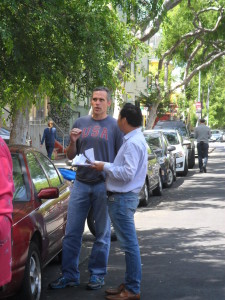
Real estate investors calculating profit margins on the potential purchase of the Pigeon Palace, May 5, 2015.
May 5, 2015: A man driving a gleaming SUV pulled over in front of an apartment building in San Francisco and let out a long, low whistle under his breath that was almost reverent. 2840 Folsom Street, a massive Victorian painted in shades of lemon yellow and chocolate brown, had banners made of bed sheets flying from every window. “Pigeon Palace 4 Ever,” read one. Another sheet, flapping and turning in the wind, read “Affordable Housing Forever.” These banners were made by the tenants of the Pigeon Palace, so-called because of the owner’s love of the birds. The building was for sale, and eviction was in the air. The current tenants had scheduled a protest that day to forestall the sale and forewarn any interested buyer that they would fight to stay in their homes.
The man parked his SUV and got out and walked over to look at the banners more closely. He looked expensive like his car: groomed silver hair, leather driving moccasins, and jeans which had been pressed. The look was a Wealthy Normcore, a low-key rendition of unstudied, luxurious ease. He stood under one of the banners, studying it. I walked over.
“Hi there,” I said. “Are you interested in buying this building?”
He looked at me. “Uh, no,” he replied. “I’m not interested.”
“No? How did you find out about this?” I gestured with my writing pad to the building.
“I was just driving by…” His words trailed off. He was mentally quitting the scene, having barely seen anything except the banners and their upstart proclamations.
“Can I get your name?” I asked.
“No,” he answered flatly. He turned on his heel and left.
The silver-haired man was probably lying. He was obviously there for a “walk-through”— a preliminary step in the eventual sale of a property. It had been scheduled that day by the state-appointed conservators of Frances Carati, the elderly landlord and owner of the property who had been declared incompetent to manage her own affairs a few years earlier by the county’s Adult Protective Services agency. She’s now living in a nursing home in San Francisco.
Frances’s father purchased the building in 1942 with his GI Bill for $12,000. Now it is worth at least $2 million. That’s the offer that was made by the San Francisco Community Land Trust, which had worked with the tenants of the building to purchase the Pigeon Palace. If the Land Trust’s offer had been accepted by the conservators, the tenants would have owned the building cooperatively and the Pigeon Palace would have been taken off the market. But the conservators didn’t accept the Land Trust’s offer and put the building on the auction block, citing their obligation to meet Frances Carati’s financial interests, which, they said, must be upheld. Two million wouldn’t cut it. The building must be sold and quickly. There would be more silver-haired men that day looking at the property, sizing up its dilapidated glory, balancing the cost of renovation against the profit it might produce, minus its current tenants.
Buyouts are the most common method for clearing a building. Low level harassment works, too. Real estate agents and speculators know that tenants will abandon their rights and their apartments, leaving them empty, ready for a quick coat of paint and maybe a new sink, before remerging on the rental market as a shiny dwelling available for $4,268.00, the median price of a two-bedroom apartment in the Mission District. I remember the elderly Latin American couple who lived down the street from me. The woman and I would greet each other equably on our way to the laundromat. “Hola,” we would murmur to each other in passing. One day, I noticed that the façade of their white stuccoed building was now a plastered a smooth slate-gray. The door to their apartment was gone. Under what conditions they’d been gotten rid off was anyone’s guess, but whether it was by preemptory command—you have to go now—or a buyout, the effect was the same. The couple had vanished, along with their door.
The tenants of the Pigeon Palace plan on staying put. As the silver-haired man sped away in his SUV, the tenants—Chris Carlsson, Adriana Camarena, Ed Wolf, Kirk Read, Keith Hennessy, and Carin McKay—were in their apartments, preparing to meet their friends and supporters outside to confront the buyers who wanted to buy the place.
Oscar Salinas was one of the first to arrive. He stood on the sidewalk reading a flyer; this was the Pigeon Manifesto, written by the tenants. It began: “Our six-unit building is called the Pigeon Palace, after the hearty rule-defying birds loved by our dear landlord Frances Carati. But oh shit! Our home is for sale! And the vultures are circling.”
Chris Carlsson, one of the tenants, walked down the steps. “Hey, there,” he said, walking over to Salinas. “Great to see you!”
“How you doing, buddy?” replied Salinas. The two men hugged.
Ian Waisler, a former tenant, walked up, smiling. “Hi,” he said to no one in particular. He sat down on the front stoop, a burrito in hand, and began eating it.
A man carrying a saxophone arrived, and looked around. “Where is everyone?” he asked. Ofir (that was his name) was a member of the Brass Liberation Orchestra, a “multigender/multiracial/multigenerational” musical group that provides a musical soundtrack for protests. He slung the saxophone around his neck and blew a few bluesy notes.
More people started arriving. I asked one them, Thom, why he was there. He hesitated. “Well…it’s simple,” he said finally. “I’m here to save my friends’ house. It’s that basic.” He looked relieved as he told me this.
Earlier, Chris had passed out a piece of paper with questions to pose to prospective buyers. “Do you know who lives here?” was one question. “What is your goal today?” was another. And “Can you imagine not evicting tenants?” The questions were simple and provocative and read like messages on a Jenny Holzer projection, designed to intervene in a process that was supposed to be smooth, unpublicized, and uneventful.
“This isn’t what people expect when they come to buy real estate,” observed the writer Rebecca Solnit, who had strolled up from the direction of 26th Street. “So I think it’s effective. But you know”—she turned her large eyes on me—“some people can create very elaborate rationales for evicting people.”
“Do you know what structure this is gonna be?” asked Thom. “Are we gonna stand around, Critical Mass style?” It would have been appropriate. Chris Carlsson is widely credited with starting Critical Mass, the monthly bike ride through the streets of San Francisco, although he flatly denies this.
Chris is a writer and the founder of Shaping San Francisco, a history project. (“History from below” is the purpose of the organization.) Chris and his co-tenants represent the now-vanishing culture of writers, artists and activists once native to America’s big cities and now becoming increasingly rare as San Francisco and New York host an influx of the wealthy, who seem intent on privatizing everything.
Privately held properties like the Pigeon Palace are not normally thought of as public space, but the distinction gets blurry when the tenants are masterful activists like Ed Wolf, a noted AIDS activist, or Adriana Camarena, founder of Unsettlers: Migrants, Homies and Mammas, a media project that investigates and chronicles the Mission District’s historic Latin American community. The Pigeon Palace became public space because of the activities that took place there. Small conventions of all sorts and for every reason made the apartments of the Pigeon Palace a public commons. Doors were open, dinners were made, plans discussed, visions brought forth. The city was shaped in the living rooms and kitchens of Pigeon Palace. The cheap rent birthed big ideas and projects: the artists, writers and activists who live at the Palace wrote books, edited anthologies, painted gorgeous murals, fought for health care during the AIDS crisis and, generally speaking, critically reflected San Francisco’s mythic past, muddled present, and vaunted future back out to the city. In a city where renters happily fork over 50 percent of their paycheck in order to live in a city enriched by ‘culture,’ people like Chris are being shown the door, while the work they did, which gave the city its identity as interesting and provocative place to live in, is both un-remunerated and monetized every time a real estate agent or development LLC refers to “vibrancy.” Your work here is finished, is the message.
By 2:00 p.m., about 70 protestors stood in front of the Palace. The Brass Liberation Orchestra swung into their version of “Ghost Town” by the Specials. The lyrics had been changed. “Do you remember the good old days before the tech town?”
Some real estate agents had shown up with their clients in tow; some prospective buyers came on their own. They were easy to spot. Most of them were well-groomed males, clutching large iPhones that looked like the black obelisk from 2001: A Space Odyssey. One of them stood next to a protestor. That he was a buyer was clear: his skin glowed, and hair wax held his glossy curls in place. He was scented pleasantly with cologne and in a mood to talk.
“So…how many people live here?” he asked chattily.
The protestor handed him a manifesto. “Read that.”
The buyer glanced at it. “How much are they selling it for?” I felt this question was disingenuous. Wouldn’t he know? “You know,” he continued, crossing his arms and crushing the manifesto to his chest, “I’ve read the People’s History of San Francisco.” (There is no such book.) This comment was aimed, ostensibly, at the man next to him, but also, perhaps, for the benefit of whoever might be listening. I walked over to him.
“Are you interested in purchasing this building?” I asked.
“Yes,” he said quickly. He didn’t want his cover blown. It was fascinating watching him vacillate between two identities: the role of the innocent bystander with his air of faux-naiveté and bewildered innocence—hey! I just happened to stumble across this really interesting protest!—and the venal real estate guy, out to make a killing in San Francisco’s insane housing market. He didn’t want to be seen in vulture mode, and so was taking refuge in his Candide-like posture of feigned innocence.
He was also totally fascinated by the scene of celebratory dissent playing out before him: Chris was dancing an improvised two-step with singer Suzanne Sterling, while the Brass Liberation Orchestra played a tune that sounded like a Kurt Weil song from The Threepenny Opera. Pigeon Palace supporters were circulating through the crowd, proffering manifestos to startled real estate agents and buyers. Neighbors chatted on the doorstep amiably. It was time to protest, but also time to catch up on the day’s, the week’s, the month’s doings. I heard someone greet another person with enthusiasm (“I haven’t seen you in forever!”). Glenn, a tall thin man with a porkpie hat and gentle smile, drifted through the throng with a sign that read, “End Economic Cleansing.” (His height gave this sign the advantage.) The chatty man who wanted to buy the building whipped out his enormous black phone and started talking animatedly.
I walked over to another couple: a middle-aged Asian man and a tall handsome guy with a haircut like a Homecoming King from the Fifties. He was nervous. His eyes darted around and his hands were gripping his hips. I started to ask them the now standard question—“Are you here to buy?”—but the middle-aged man interrupted me.
“You know,” he said, “it’s frustrating to be seen as criminal. Why is it evil for him”—he jerked his thumb at the Homecoming King—“to want to buy this? To clean it up? You know, renovate it, make it nicer? Don’t you think these people deserve a good home?”
I tried asking my question again: “Are you here to buy this building? Can I ask you some questions?”
“Sure,” said the middle-aged man. The Homecoming King looked away.
“Do you know who lives here?” I asked.
The Homecoming King snorted with derision, and suddenly came to life. “Do I know who lives here?” he asked incredulously. “How would we ‘know who lives here’? We’re buyers. How would we know that?” His handsome face was twisted in disdain.
Whoa, I said to myself. Simmer down, guy. The Homecoming King had suddenly morphed into an asshole; he reminded me of a villainous jock from a John Hughes movie.
“Good luck,” he snarled sarcastically and stomped away. Daniel Hirsch of Mission Local, an online newspaper, started interviewing him. “I’ve lived here for twenty years and worked my butt off,” the Villainous Jock (as I now thought of him) exclaimed heatedly. “I’m here because this building is for sale.”
“Are you a real estate agent?” asked Daniel politely.
“No,” said the Villainous Jock with irritated sarcasm. “I’m not a real estate agent. This isn’t a specialty.”
Behind him, cars drove by, honking in support. “Whoo-hoo,” the drivers yelled. Chris led the crowd in a chant. “Who’s in the Palace? Pigeons! Pigeons! Who wants to eat them? Real Estate Vultures!” The crowd shouted the chant with glee. Someone handed me a flyer. “Mission Neighbors,” it read. “Don’t support W-K Liquors on the corner of 24th and Folsom as they recently bought the building and are wrongfully EVICTING an 82-year-old Veteran.” I walked up the steps from the sidewalk and leaned on Chris’s doorframe, looking at the crowd. Beyond the fringe of happy protestors were buyers, staring at the scene, their faces slack in disbelief.
We have to walk through that? you could see them thinking.
Who are these people, I wondered. What is their goal?
And suddenly, they were walking into the apartments, breaching the defenses, storming the portals. A petite pregnant woman, kitted out in yoga clothing, passed quietly through Chris’s door and up the stairs to the second floor. I had seen her in the crowd and thought she was one of the protestors. But now, walking up the staircase to Chris’s apartment, it was clear what she was in that moment of ascendant aspiration: a potential evictor.
A man walked past me. “Are you here to buy this building?” I asked. I followed him partway up the stairs.
“I’m thinking about it,” he answered.
“Do you know who lives here?”
“These people,” indicating the crowd with a vague wave of his hand, “I guess.” He laughed.
“Can you imagine not evicting them?” This was a twist on the more obvious question. Keith Hennessey had written these questions to goad them toward an act of audacious anti-capitalist imagination: imagine not evicting them.
“I haven’t gotten that far yet.” He walked up the stairs.
As I walked down the stairs, I saw another man on the landing, wearing a motorcycle helmet. Close on his heels was a woman with wavy brown hair and round eyes which looked tearful. She was a bit out of breath.
“Excuse me,” she said to the man wearing the motorcycle helmet. “Can I ask you what your goal is here?”
He stopped and looked at her. “Why?” he asked.
“I’m just curious. I lived here for many years and I raised my son in this apartment. I don’t want this building sold or these people evicted. What is your job?”
“I’m a real estate agent,” he told her and turned to walk up the stairs. I tried to slip past him and out the door. But the woman had stepped inside, blocking my exit.
“So, what are you thinking here? Are you going to evict these people?”
“I don’t know! I’m just looking around!” He walked upstairs. The woman followed him.
Outside, Chris began to address the crowd. “What we are trying to do here is not acquire this as private property,” he said. “We’re committed to this being affordable housing. Not just for us. The big goal is to get this building off the market forever and maintain it for housing for San Franciscans in perpetuity.” The crowd whooped its approval. “We really have a deeper challenge here, which is to challenge the organization of life. To challenge the housing logic is the beginning of that fight. It’s one of many fronts. There’s a meme that people use,” he said indignantly. “They say we’re trying to ‘get away’ with something, that we just want cheap rent, that we’re acting entitled. Well fuck yes, we are entitled! We’re entitled to live full lives, to make art, to create culture, and to live in such a way that brings meaning and joy to our lives.”
Entitlement: it’s a charge gaining in popularity as a political formulation, sure to be pressed into service by landlords and real estate agents who see the end of rent control as key to clearing the city of tenants who are protected by it. “Don’t buy this building,” Chris said. “We’re gonna make your life hell if you buy it. It’ll be a hornet’s nest.”
I believed him. Of all the multi-unit apartment buildings in San Francisco, the speculators and evictors had come to this one, not knowing who lived here, not knowing that, unlike other people in my neighborhood who walked away from their rights in passive acquiescence of something that looked like fate to them, things would be different here, in this building, with these tenants. We’ll make your lives hell.
I went upstairs and sat down in Chris’s kitchen. The woman with wavy brown hair finished her conversation with the helmeted real estate agent and sat down next to me, looking distressed.
“I’m Marian Doub,” she told me. “I raised my child in this apartment.”
A woman with neatly combed brown hair joined us. She knew the deposed landlady, Frances, and had gone to visit her the other day.
“I’m deeply, deeply disturbed by what I see going on here,” she told us. “Frances speaks very highly of her tenants. She seemed very clear-headed to me.”
“This is a part of the picture that is really disturbing. She’s been labeled incompetent,” responded Marian.
“Oh, it’s more than disturbing. I find the whole situation repulsive,” answered the woman.
A man in his mid-sixties walked into the kitchen, head thrust forward. He seemed to be looking for someone.
“Hi,” he said aggressively. “Is this place being shown today?”
“Well, no, actually,” said Marian. “We’re not cooperating with that process.”
The man scratched his head and muttered to himself.
“I’m Marian Doub. I lived here for about six years.”
“I’m Mike Bernstein,” he said.
“What’s going on with you?” asked Marian, comfortably, in a capable, practiced manner. “What are your goals here?”
“What’s going on with me? I just broke up with my girlfriend,” he responded.
Marian laughed. “I’m sorry to hear that.” Her brow was furrowed. Why is this guy talking about his girlfriend?
“I swung by to look at the place, and I wanted the microphone, but they wouldn’t give it to me,” he complained.
“What did you want to say?” asked Marian.
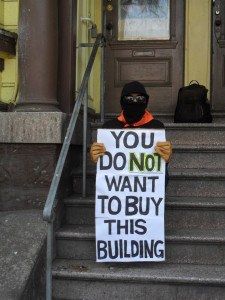 “The inference is that every investor is, uh, an evil, uh, money-hungry…”—he cast about for the right epithet to describe the way his detractors seemed to be describing him—“…insensitive person that doesn’t care about people and is just trying to squeeze as much money out of the place as they can. And there are many like that,” he said with wide-eyed earnestness, “but my partner and I aren’t like that! I took offense to throwing the same blanket over us that landlords throw over all tenants! It becomes so polarized. There’s got to be a solution!” He shook his head, clearly in despair. “Do you live here?” he asked quickly.
“The inference is that every investor is, uh, an evil, uh, money-hungry…”—he cast about for the right epithet to describe the way his detractors seemed to be describing him—“…insensitive person that doesn’t care about people and is just trying to squeeze as much money out of the place as they can. And there are many like that,” he said with wide-eyed earnestness, “but my partner and I aren’t like that! I took offense to throwing the same blanket over us that landlords throw over all tenants! It becomes so polarized. There’s got to be a solution!” He shook his head, clearly in despair. “Do you live here?” he asked quickly.
“No, I don’t,” said Marian. “I lived here about six years ago.”
“So, if, if, if the land trust is not successful—which I don’t think they’re going to be—then to scare off a pair of guys like Paul and myself, is…well, you’re gonna be your worst enemy!” Clearly a large part of his psyche was still outside addressing the unruly protesters, who had so rudely denied him his right to lecture them, to explain the facts of life. We’re nice guys! I’m not evil! You’re wasting your time! “Our plan is to renovate nicely the two vacant units—I’m sure you have an idea of how much they would bring in—to the point where we wouldn’t be interested—not interested at all—in tampering with anybody’s living space.”
“You need…” began Marian.
“I think demonizing…” he interrupted.
“You need to listen to me,” said Marian. “Let me finish my sentence. We wanted to stay in San Francisco. We lived here, but it was substandard housing. We had a kid, and Frances didn’t like us having a kid, and she wouldn’t let us fix the apartment up, so we jumped ship.” In 2004, she and her husband bought a two-unit house—“off-market”—in Bernal Heights. “We have tenants. We’ve never raised the rent. The two women are still there, seven years later. And we’re very happy about that. So, it’s a question of being good landlords, too, right? How are we to be good landlords? ’Cause being a landlord is kinda”—she scrunched her face up—“like, eeww. You know it’d be better to be in some kind of land trust with cooperative ownership.”
“But, but, but”—he seemed to be doing an uncanny imitation of Nathan Thurm, the sleazy lawyer portrayed by Martin Short on Saturday Night Live—“but whoever buys this place is not going to be encumbered by any legal restrictions. They can do whatever they want.”
“What I’m saying is that you would need very, very strong, legal agreements with the tenants. That’s what it would take for them to actually believe you. If you wanted more cooperation,” said Marian patiently, “you’d have to really show up on your side of the table. If you want people to not put up a fuss and fight tooth and nail, which we are going to do…”
He broke in. “If the Land Trust doesn’t buy it, you’re saying fight tooth and nail.”
“Against eviction? Yes,” said Marian.
“Against, against any…” he started sputtering. “Of course, I don’t blame you! But are you going to fight tooth and nail against any sale of the property?”
The word Yes hung in the air. “That’s up to them,” Marian said.
“I can’t imagine what grounds you have to fight it,” Bernstein retorted.
Marian permitted herself an incredulous laugh. “Well, because, people deserve to live in their homes.”
He spoke over her in a soothing tone: the pragmatic lawyer preparing an ignorant claimant for disappointing news. “I understand, I understand. But I’m also a lawyer. I understand the law. You cannot stop the sale of a property.”
“Back up,” said Marian. “What about dialogue?”
“Why do you think I’m here?” he said indignantly.
“This is beautiful,” she told him. “But I don’t live here.”
He stopped and looked at her intently. “I’m sorry,” he said. “What’s your name?”
“Marian,” said Marian.
“Maryanne? Miriam?”
“No. Marian. Like Maid Marian,” she said.
“I’m just wondering if there’s some way”—he made a show of thinking—“that…maybe…you could sell it to us!” This, as if he’d just made a startling discovery, a finding of an undiscovered fact. Eureka! You could sell it to us. He laughed delightedly, self-consciously. (His brilliance, it seemed, was both a gift and a burden.) He didn’t seem to grasp the most basic facts about their encounter: she wasn’t a tenant, and moreover, she wouldn’t have sold him a ham sandwich at that point, much less a multi-unit apartment building filled with tenants.
Marian just looked at him. She sighed audibly.
He excused himself and bustled out of the apartment. He was later quoted in an article by the online newspaper 48 Hills as saying that, although he wouldn’t evict tenants, he would offer them buyouts to “encourage them to leave.”
Marian said to me, “San Francisco has to get hugely more aggressive in terms of progressive housing.” She has a degree in urban planning and heads her own firm as a consultant in community-based economic development. “It’s my living. I know all the models. There are multiple strategies and models out there that are not getting supported. There’s all kinds of programs out there for what is called financial capability programs, meaning, like, first-time homeowners. Take the Mission Economic Development Agency. They have a very strong first-time homeownership program. There are agencies out there that have the infrastructure that could work very closely with the San Francisco Community Land Trust to ramp it up.” (The “it” being affordable housing , presumably.) “It’s not hard. If the will is there, there’s plenty of professionals in San Francisco that could make this happen. It absolutely could happen.”
“What is your goal today?” I asked Marian.
Her eyes filled with tears. “Help my friends stay in their homes?” she said in a trembling voice. “For me, it’s home. We’re sitting in the living room where my child was a baby, and then a toddler, and then a preschooler. We had a parent co-op playgroup here. It’s not okay that people get pushed out and evicted when we’re living full lives. And even when we’re not!” She laughed ruefully. “It’s a right.” She meant having a home.
****
Four days later, a bid was placed on the Pigeon Palace for $2.3 million, more than the San Francisco Community Land Trust had offered.
****
Six weeks later, tenants Carin McKay and Kirk Read sat in a courtroom of the Superior Court of California. Open bidding on the Pigeon Palace was scheduled to take place that day; Carin and Kirk were making a last-ditch effort to stop the sale by lodging a formal objection. “All rise,” said the bailiff. The tenants, their supporters and the bidders rose to their feet obediently.
The auction got underway after Judge Peter Busch made short work of the arguments from the tenants’ lawyer. “I’m going to overrule the objections,” he said sternly. “We’re going to go ahead with the sale. This is going to be a sale of 100 percent of the interest in 2840 to 2848 Folsom Street in San Francisco. The bid amount is 2.3 million.”
The bidders introduced themselves one by one: among them was Sergio Iantorno, the owner of four limited liability corporations and one of the “dirty dozen” serial evictors named by the Anti-Eviction Mapping Project. According to them, Iantorno is currently evicting 19 units and 41 people. He sat in the front row in a wheelchair, an elderly man with a prominent wart on the tip of his nose, surrounded by Tim Graffigna, the LLC’s purchaser, and three tough looking young men. (“Are they his bodyguards?” someone wondered in a stage whisper.)
Richard Hurlburt, the lawyer representing the San Francisco Community Land Trust, sat in the back of the courtroom, a compactly built man with round glasses.
The first bidder, Tim Carrico, made an offer for $2,420,750. The atmosphere inside the courtroom, already tense, ratcheted up. Within one minute, seven bids had been placed. Hurlburt sat in the back of the courtroom, body language relaxed and eyes alert behind his glasses. “2.53 million? 2.53 million?” Judge Busch asked. Hurlburt raised his hand. Graffigna offered a counter-bid. The judge raised the price another ten thousand dollars. Hurlburt raised his hand. Graffigna bid again. Then Hurlburt. In another minute, the bid stood at 2.62 million. Carin sat still, her back stiff. Everyone stared at Hurlburt, who sat calmly. Thirty-five bids came in quick succession, the numbers soaring to three million and beyond.
At 3.16 million, Iantorno stood abruptly and pushed his wheelchair away. “Your Honor, I am the bidder here. I am sorry,” he said. “I’m handicapped. Your Honor, I want to make sure that the Court knows that the money, the 10 percent, is available now.” He breathed heavily and looked around the courtroom.
Hurlburt sat, legs crossed.
“Any sale here is going to be on the terms and conditions that are set out in the report of sale May 18, 2015, and I trust everyone understands that,” responded Judge Busch evenly.
The bidding—now between the San Francisco Community Land Trust and Iantorno—continued. The numbers continued to climb. It was as if the oxygen had left the courtroom. Carin sat. Her supporters glared at Iantorno. Faces appeared framed in the window in the courtroom door looking worried, interested, perplexed. The people in the hall couldn’t hear the bidding. Mike Bernstein, the would-be landlord of the Pigeon Palace, was one of them. He had arrived after 9 a.m., surprised to see the courtroom already full. He could be seen speaking with a Pigeon Palace supporter and gesturing vigorously.
“I’m going to lose my voice,” said Judge Busch. “3.26 million from Mr. Hurlburt. 3.27 million?”
Iantorno said disbelievingly, “What’s the last bid, sir?”
“The last bid was 3.26 million. I’m looking for at least 3.27 million,” said the Judge.
Graffigno put up his hand. Carin looked down at her lap.
“I have 3.27 million. Do I have 3.28 million?” The judge asked. Graffigno and Iantorno looked at each other.
Hurlburt put up his hand. “3.28 million,” he said. There was silence.
“Do I have 3.29 million?” asked Judge Busch. “Going once. Going twice.” He paused and looked sharply at Iantorno whose face was impassive. “Anybody else want to jump in?” He folded his arms and looked at the courtroom. It should have been possible to hear the beating of every heart in the courtroom, so still was that room. “I have 3.28 million going for a third time,” said Judge Busch breaking the silence. “All right. The property is sold for 3.28 million.” He made a notation on his pad and looked up. “I want to thank everybody for your participation. This has obviously been a very spirited auction.”
The courtroom, so still just seconds before, erupted as supporters clapped jubilantly. The bailiff opened the door. The new owners of the Pigeon Palace picked up their belongings and left the courtroom.
[ed.: As of today, July 9, 2015, the deal is still progressing. There are many hiccups but so far so good. If all goes well, the deal will close escrow around August 15 and the Pigeon Palace will become a San Francisco Community Land Trust property; the tenants are honing their self-management agreements and structures while holding their breath til the deal is done.]

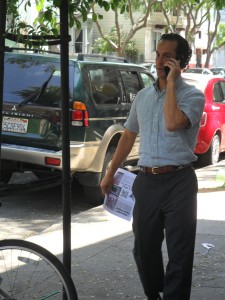
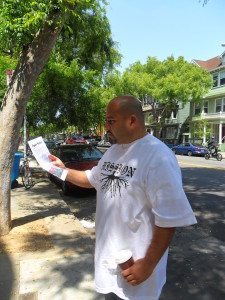
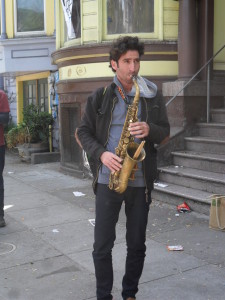
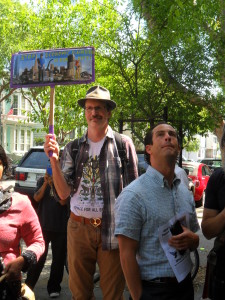
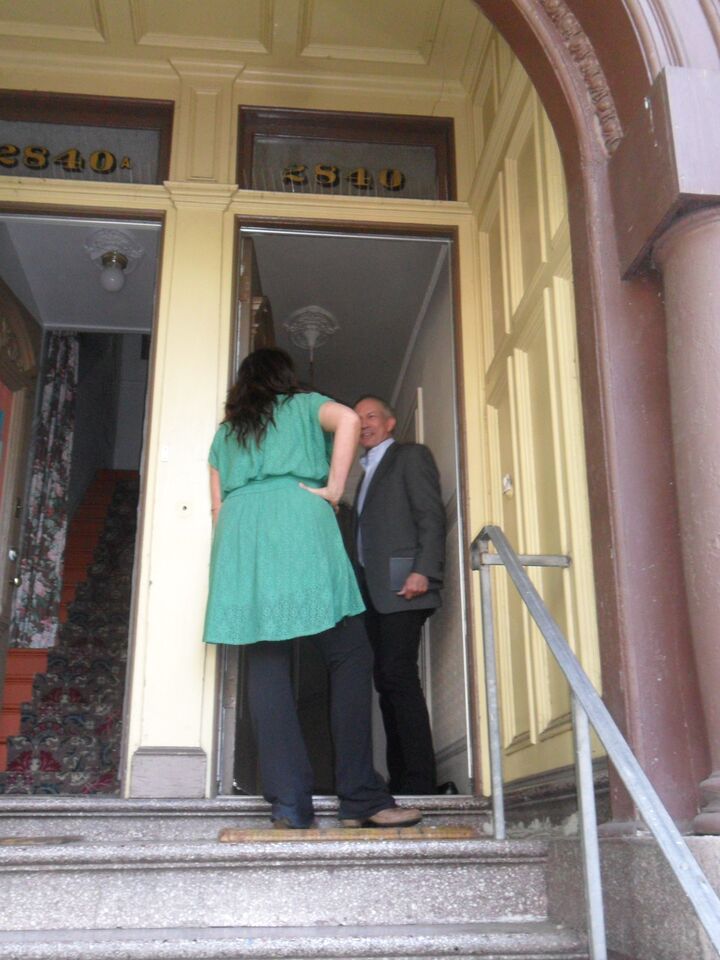
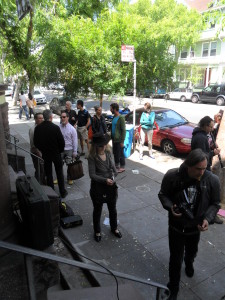











Leave a Reply